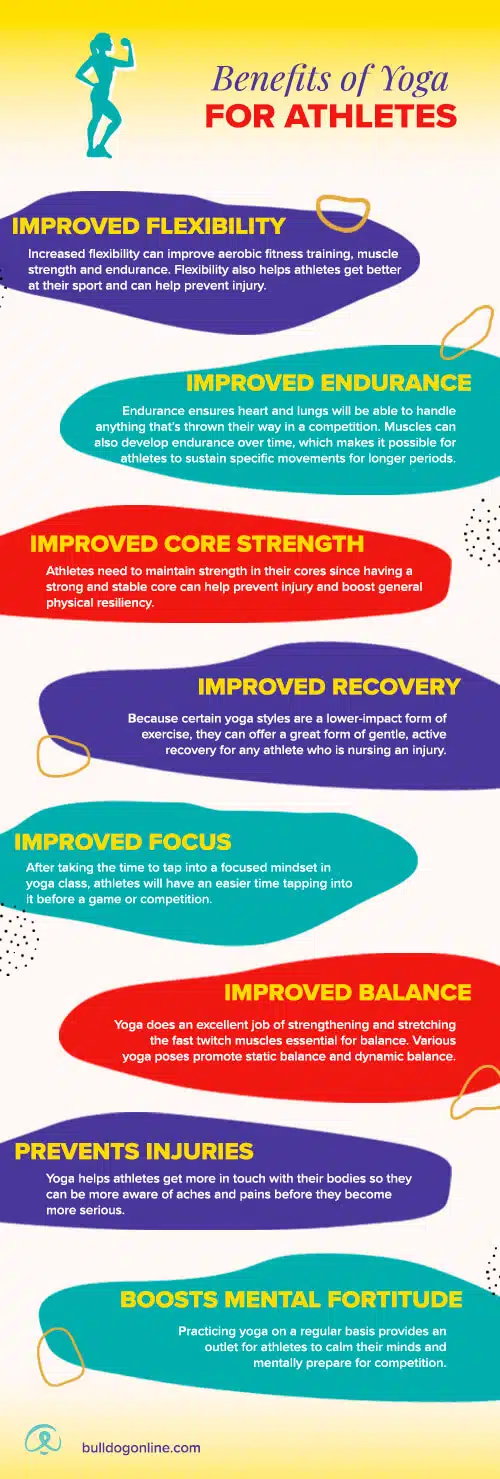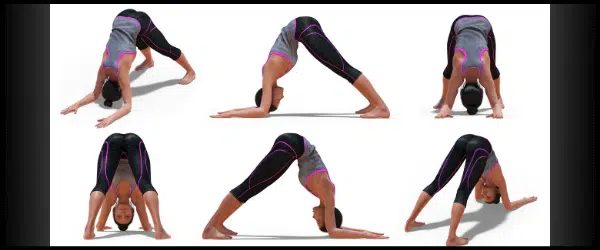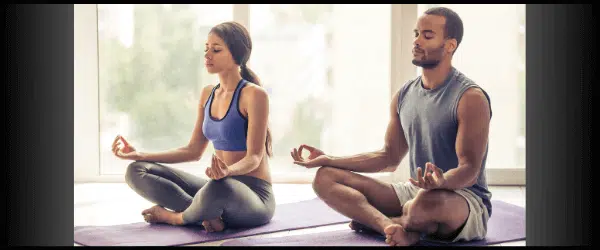Adding a yoga practice can benefits athletes both physically and mentally. Yoga is more than just relaxation. Take a look at why athletes love yoga and depend on its many benefits.
For far too long, yoga has been flying under the radar as an amazing workout for athletes of all kinds. People who haven’t explored the practice yet might think of it primarily as a route to meditation or as an exercise meant purely for stretching.
It can be those things — but it actually has even more to offer, including many tangible health benefits that athletes at every level can bring to their game and their overall fitness level.
Yoga is a great addition to any athlete’s fitness regimen and here’s why.
Table of Contents
Yoga for Professional Athletes
Yoga As a Performance Enhancer
Are you a runner? We’ve got a class just for you!
Keep on keepin’ on!
The Benefits of Yoga for Athletes
Yoga’s well-rounded health benefits have been so thoroughly documented that it’s no wonder athletes have started flocking to it! Yoga — especially power yoga, which is more cardio-based — is a full-body workout that builds strength, endurance, and flexibility.
Athletes need all of these things to become stronger at their sport of choice! More mellow yoga classes can also give athletes a much-needed opportunity for stretching and active recovery between games and practices.
Check us out
Check out a free Beginner Yoga and Bootcamp class to see what we’re all about! 😎
MORE BENEFITS OF AN AT-HOME FITNESS REGIMEN
Gain Flexibility
Per the University of California, flexibility is “the ability of a joint or series of joints to move through an unrestricted, pain-free range of motion.” Everyone’s flexibility is a little different, but we all require a minimum level of flexibility in order to maintain general wellness and to complete day-to-day tasks. Athletes need to be more flexible than others, since increased flexibility can improve aerobic fitness training, muscle strength, and endurance. Flexibility also helps athletes get better at their sport and can help prevent injury.
A 2016 study published in the International Journal of Yoga proves yoga’s effect on flexibility for athletes. The study followed a group of athletes for a period of ten weeks. Some of the athletes participated in biweekly yoga sessions, while others did not. The athletes who did practice yoga demonstrated significant gains in flexibility at the end of the study, based on a series of fitness tests, measurement of joint angles, and performance of a series of three yoga poses.
Greater Endurance
Endurance is the ability to sustain a specific activity — running, swimming, cycling, etc. — for an extended period of time. In order for athletes to gain endurance, they typically participate in endurance training, which ensures their heart and lungs will be able to handle anything that’s thrown their way in a competition. Muscles can also develop endurance over time, which makes it possible for them to sustain specific movements for longer periods. In order to be successful at their sport, athletes must have plenty of endurance so they can stay in the game no matter what happens and outlast the competition!
According to Harvard Health, research has proven the positive impact of yoga for endurance. One study followed a group of people trying yoga for the first time for eight weeks. At the end of that eight-week period, participants had greater endurance. High-impact yoga styles (like power yoga, one of our favorites here at Bulldog!) is especially good for building endurance for athletes, since it gets your heart pumping like other forms of cardio exercise.
Many Olympic athletes — who you might call poster children for endurance — use yoga as part of their training programs. Cyclist Evelyn Stevens and swimmers Rebecca Soni and Ariana Kukors are three of many Olympians who have shared about the role yoga has played in their intense regimens.
Improved Core Strength
Harvard Health defines the core as “a group of muscles that stabilizes and controls the pelvis and spine (and therefore influences the legs and upper body).” The core is made up of your abdominal and lower back muscles. Having a strong core is important even for non-athletes, since it’s your core that is responsible for movements as simple as sitting up straight without pain! Athletes need to maintain strength in their cores even more, since having a strong or stable core can help prevent injury and boost general physical resiliency.
The Cleveland Clinic notes that there are many specific yoga poses that can help athletes (and others!) strengthen their core muscles, including planks, Boat pose, and Chair pose. Plus, moving through a faster flow in a more intense yoga class can go a long way toward tightening and training those muscles.
Faster Recovery
Even the toughest, strongest, most prepared, and talented athletes are bound to fall prey to the occasional injury. At every level of competition, athletes find themselves working their bodies so hard — and, depending on the sport, putting themselves in danger. Getting hurt is pretty much inevitable. But a long recovery doesn’t have to be!
For athletes, speeding up the recovery process after an injury is essential. The sooner you recover from an injury, the sooner you’ll be back in the game, showing off all your hard work and training and (in some cases) supporting your team. Recovering quickly isn’t enough, though — you also want to recover as effectively and thoroughly as possible to avoid putting your body in further danger.
Because certain yoga styles are a lower-impact form of exercise, they can offer a great form of gentle, active recovery for any athlete who is nursing an injury. Be sure to consult a doctor, trainer, or yoga instructor to design a yoga regimen that can help you recover without flaring up your existing injuries.
Improved Focus
Being an athlete is about being more than just being physically strong. Taking your game to the next level also requires a certain level of mental fitness. Focus is critical, since athletes who can routinely tap into a focused headspace before a competition will likely excel beyond athletes who can’t.
Athletes who struggle with focus might consider giving yoga a try! According to UC Santa Cruz, yoga has been proven to have many cognitive benefits, including improved concentration, mental clarity, memory, retention, and focus. These benefits likely come from the mind-body connection that yoga practitioners gain on the mat. After taking the time to tap into a focused mindset in yoga class, athletes will have an easier time tapping into it before a game or competition.
Better Balance
Balance is necessary for anyone who wants to move through their daily lives without falling down, but it’s bigger than that for athletes! Having a strong sense of balance in the body allows athletes to move more efficiently.
According to Harvard Health,
“Yoga does an excellent job of strengthening and stretching muscles essential for balance.”
Various yoga poses promote static balance (the ability to stand in one spot without swaying) and dynamic balance (the ability to anticipate and react to changes as you move). Dynamic balance is especially key for athletes on the move!
Prevents Injuries
We’ve already mentioned the inevitably of injuries for athletes and told you about yoga’s ability to ease and expedite the recovery process if you do get hurt. But what if you could actually prevent injury before it happens so you can skip that pesky recovery process? Yoga has been known to do that!
It comes down to the improved balance and flexibility that we discussed earlier. Increasing balance and flexibility can reduce an athlete’s chance of injury. Yoga also helps athletes get more in touch with their bodies so they can be more aware of aches and pains before they become more serious.
Boosts Mental Fortitude
Many people turn to yoga to help reduce depression and anxiety. Athletes can experience a very specific type of anxiety — performance anxiety! Before a competition, nerves may run the risk of interfering with an athlete’s game. Practicing yoga on a regular basis may provide a new outlet for athletes to exercise their nerves and calm their minds to prevent choking on day they’re set to compete.
Interested in learning more and seeing poses in action?
Everything you need to know!
Yoga Poses for Athletes
Now that you’re clued into the awesome benefits of yoga for athletes, you’re probably ready to give it a shot. A full-on yoga class will give you the opportunity to go through an entire flow of movements that will benefit your overall wellness, but you can also test out single poses to see how your body responds. Almost any yoga pose will have benefits for athletes (or anyone else!), but we’ve chosen five to get you started: Cobra, Dolphin, Sumo Squat, Boat Pose, and Pyramid.
Cobra
To complete Cobra pose, lie with your legs straight behind you and the tops of your feet pressed into the floor. Your hands should rest on the floor below your shoulders with your fingers spread wide. Keep your elbows pressed tight into your sides, then push through your hands to straighten your arms and lift your chest off the ground. Your lower body should remain pressed into the ground. Hold for 15 to 30 seconds, then release.
This is a great pose for athletes who put a lot of stress on their lower back muscles during workouts and practices. And it’s a fantastic spinal stretch.
Dolphin
Begin on your hands and knees. Place your forearms on the ground so your shoulders are directly above your wrists. Pressing your palms together, curl your toes under and lift your knees up and away from the floor. Lengthen your tailbone as much as possible and lift your hips toward the ceiling. Continue pressing your arms against the ground. Hold for 30 second before releasing to the floor.
Dolphin pose will stretch your upper back, shoulders, hamstrings, calves, and foot arches — all at the same time! This is perfect for athletes who are looking to maximize range of motion throughout their bodies.
Sumo Squat
Stand with your feet wide. Turn your toes out to a 45-degree angle. Brace your core, then bend your knees and hips to squat down until your thighs are roughly parallel to the ground. Hold the squat, engaging your inner thighs and hips! When you’re ready, push through your feet to stand up.
Athletes looking for new ways to work their core and lower body will find plenty of benefits to adding Sumo Squats into their regular routine.
Boat Pose
Begin seated with your knees bent and your feet flat on the floor. Your hands can rest on the floor next to your hips. Lean back slightly, keeping your spine straight. Lift your feet, bringing your shins parallel to the floor. Draw in your lower back, lift your chest, and think about lengthening your torso. Straighten your legs to a 45-degree angle, bringing your body into a V-shape. Slowly release back to the floor.
Remember what we said about strengthening your core? This is a great way to do that! Athletes will find that Boat pose boosts the muscles in their abdomen and lower back.
Pyramid
Stand with your arms at your sides, then turn to the left and step your feet three to four feet apart. Place your hands on your hips. Aligning your heels to each other, turn your right foot 90 degrees so your toes point perpendicular to your other foot.Turn your entire torso to face the same direction as your front foot. Draw your left hip slightly forward, squaring your hips. Slowly fold down and extend your torso over your front leg. After holding until you feel a stretch, switch sides.
Pyramid pose can benefit athletes by strengthening and stretching the entire leg and spine, lengthening hamstrings, and strengthening core muscles.
Check out these poses and more
Simple ways to up your game!
Yoga for Professional Athletes
Still not convinced that athletes can benefit from yoga? Let’s bust that myth right now. Alex Morgan, Shaquille O’Neal, LeBron James, Tom Brady, Kareem Abdul-Jabbar, Maria Sharapova, Ray Lewis, Hope Solo, Kevin Garnett, and Vernon Davis have all shared that yoga is part of their routine.
Our Favorite Quotes:
“There is no way I could have played as long as I did without yoga. My friends and teammates think I made a deal with the devil. But it was yoga that made my training complete.” — Kareem Abdul-Jabbar
“Yoga isn’t just about the body. It’s also about the mind, and it’s a technique that has really helped me.” — LeBron James
“I love yoga. There’s a lot of stretching involved, which helps with my flexibility and injury prevention.” — Alex Morgan
Yoga As a Performance Enhancer
According to USA Today, the NFL has been integrating yoga for players nationwide in recent years, even if “football players don’t fit the mold of a yogi” and “most do not look capable of the contortions required of the ancient discipline.” Sports Illustrated notes that yoga is also on the rise in the NBA.
“Obviously (yoga) helps with flexibility, what we call joint integrity, discipline, focus, and balance,” LA Chargers Director of Football/Medical Services James Collins told USA Today. Collins has been training in the NFL for more than three decades. “[Yoga] has a lot of different entities to it. And one thing about professional football players is that if you explain something to them and give them the science and reasoning behind it, you can get them to buy into it.”
The science to support yoga as a performance enhancer for athletes is clearly there, so it’s no wonder top-tier teams are getting into it!
Mental Benefits
Pro athletes need to take just as much care of their brains as they do their bodies! After all, sports are a mental game, too. Tending to mental fitness and clarity is a key element to athletic success. Yoga has plenty of mental benefits to offer athletes at every level.
According to Healthline:
Yoga has been proven to decrease stress, relieve anxiety, fight depression, improve focus, and support sleep quality.
All of these things can help athletes raise their game!
Whatcha waiting for?
LeBron is onto something! 😉









